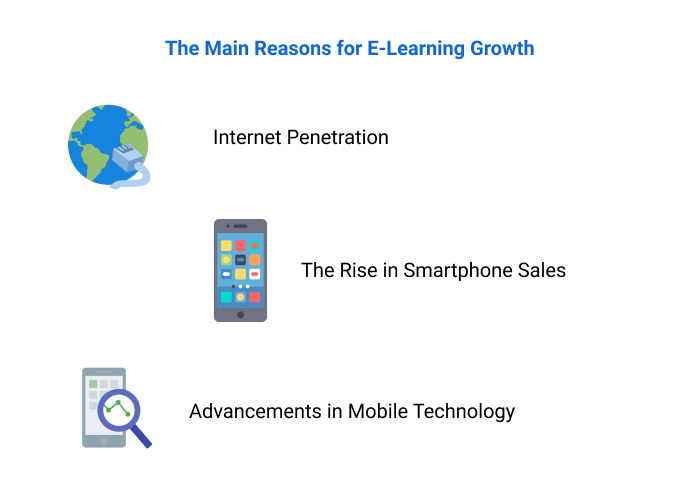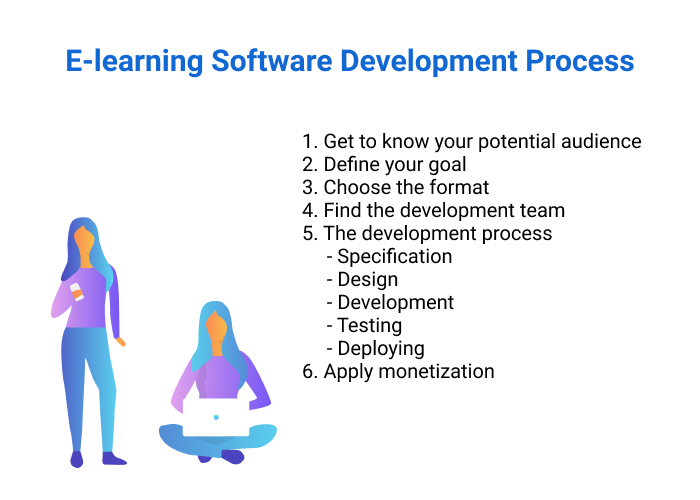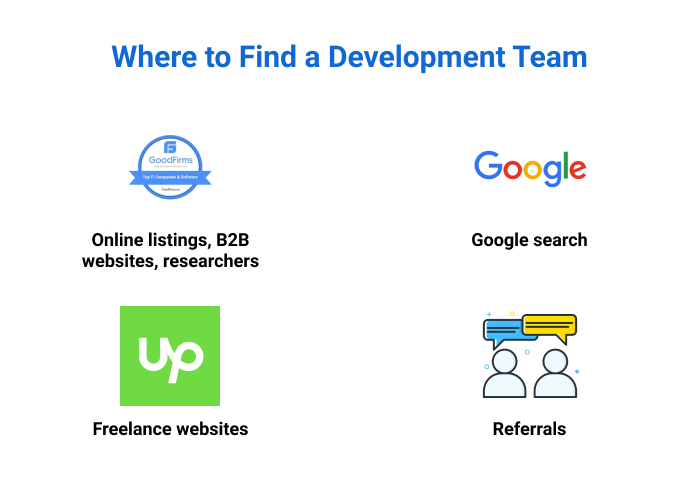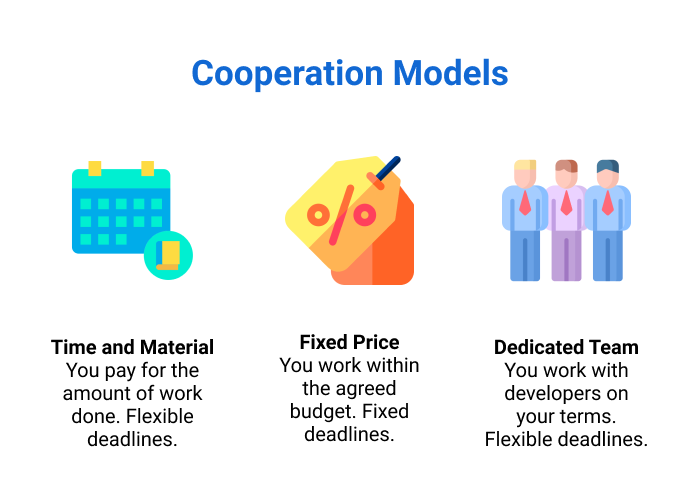Education is a challenging sphere to be a part of. The world of e-learning often lacks standards, transparency and clear communication, and may leave much to be desired in terms of accessibility.
Below we’ll look at what it takes to build an effective educational platform and how to create an e-learning app, taking into account the complicated nature of such apps.
Is There a Demand for E-learning Solutions?
In recent years many circumstances have led to the growing prominence of digital education. The best part of these changes is the fact that more people are able to access education through e-learning platforms, because of:
- Internet penetration. The whole world is rapidly gaining access to the internet. And more and more institutions worldwide are recognizing the value and accessibility of instant data exchanges, which help to optimize workflows.
- The rise in smartphone sales. Today, more people access the internet through a smartphone than a computer. In developing countries, the mobile experience is usually the first interaction people have with this technology. The reasons are obvious: smartphones are cheaper than laptops, and there are many companies that provide devices that almost everybody can afford.
- Advancements in mobile technology. Sometimes the software is only as good as the hardware that it runs on. If the software can run effectively only on very powerful hardware, then you will cover only a small portion of the smartphone userbase. But now, with affordable smartphones having great storage capacities, decent amounts of RAM, and 4G connectivity, more people can actually run such apps on their devices.
Factors influencing adoption of e-learning solutions.
So, the Internet is everywhere, and lots of people have access to it. But who is willing to invest in e-learning?
Mostly, the demand comes from two major sectors. Those are:
- Full-blown education. Everywhere, universities and schools are looking to transfer some of their educational programs online.
- On-site training. Here the range of potential clients is wide, including a broad range of corporations and industries who need easily accessible, standardized programs to train their employees.
Two major sources of demand for e-learning platforms.
Depending on the organization, e-learning software can differ greatly in its features, size, complexity, and content.
Types of E-Learning Software
The complexity and diverse nature of education demands several types of e-learning apps.
- E-learning software project. This is the broadest term, which includes a huge variety of courses on different subjects, all of different difficulty and duration.
- Customized education system. This is a specific e-learning solution targeted at a particular group of users. For instance, it can be a solution that helps kids in primary school learn to read and write.
- Gamified education. Gamified educational software, which makes learning fun, is a better fit for young users. It provides the possibility of deeper engagement and therefore deeper understanding of the topic or the issue.
- Professional training system. This type of e-learning software can benefit businesses by taking the place of a human instructor to bring down costs, increase efficiency and improve accessibility to training.
4 major types of e-learning solutions.
That’s pretty much it for the e-learning software categories. But software can also improve the educational system by helping staff to manage the process of learning. Schools, universities, and businesses can achieve these goals by introducing the following software tools:
- Skills assessment solution. This type of software can be applied to testing an individual’s skills and abilities, as well as training.
- School management platform. This can be a powerful tool for organizing everything that goes on at a school or university, including managing schedules, grades, and reports. The teacher can use such a platform to interact with students: set deadlines for certain tasks, upload manuals and textbooks, have students upload their work, and more.
How Do I Build an E-Learning App?
If you want your solution to be profitable, you will need an in-depth understanding of the steps of the e-learning software development process. This includes a thorough familiarity with the niche you choose, the potential audience of your project, the steps that form the development process, and more.
Let’s take a closer look at the step-by-step approach to building educational software solutions.
Stages of the e-learning software development process.
Get to know your potential audience
Thoroughly studying the audience is the first step in creating a project that will do its job well. One e-learning platform won’t suit everyone’s needs. You will have to choose a certain userbase and learn what about their preferences in ways of learning and what features they want.
A clear understanding of your userbase will help you clearly navigate the development process.
Define your goal
Another way to narrow down your project is to come up with a concrete problem you want an e-learning solution to solve. Whether it is helping high school students learn a foreign language or providing training for corporate employees, having a clear goal will help you come up with a solid specification for your project.
Choose the format
Now you have to choose in which form your userbase will be engaged in learning and training. You can opt for text, audio, video. Your software might have a compilation of tests for trainees or more engaging games for children. Make sure you have a clear idea of your target audience to learn the best-fitting learning format.
Kiryl
Enterprise Sales
at CourseraTake time to decide on the content as well. Content is what breaks or makes the e-learning platform, and there are two ways you can go about creating it.
The first one is creating it in-house: having your experts compile the training themselves. Let’s say you want to create an online training system for employees to learn how to operate the factory’s equipment. You can assign one of your high-ranking employees who knows his way around the equipment to create the training. That way, you will save some money on the project.
On the other hand, you can have partners make the content for you. Companies such as IBM, Google, and even schools such as Stanford University, Yale, London Business School, and Michigan University create their own courses to make them available on e-learning platforms. This guarantees better-quality content: educational experts know how to structure the course properly, how many theoretical and practical tasks must go into the program, and which assessment models will be the best fit. Upon completing the course provided by such partners, the trainee can get accredited.
Build a technical specification
Before kicking off the development process, you’ll need to write a detailed technical document. This document must include the project goal, features, technology it needs, and time scope. The more details you clarify, the easier it is for you and your development team to understand the direction of the project. You can either do it yourself or have your dedicated team help you out.
Find your development team
This is one of the most important parts of a successful e-learning software development project. Your team of programmers will make or break the project: if they are not competent, you won’t be able to properly implement all the features you want. On the other hand, experienced developers will not only provide the service you request but also go the extra mile and apply their expertise to improving the software.
The big question is, where can you hire an e-learning development team, and how can you do it right?
Need a team of an e-learning solution?
We provide skilled professionals to tackle your project
Aleksandra Golik
Sales Manager
at HQSoftware
First, you’ll need to look for a company that provides software development services. You can go about this in several ways:
- Online listings, B2B websites, researchers. Look for sites that compile data on the best software development companies in certain fields. You can find detailed information on their expertise, services, and rates.
- Freelance websites. Freelance websites are filled with independent contractors ready to take on any job. You may find somebody in a short period of time, but be cautious: sometimes contractors are less experienced than a full-fledged outsourcing company with established expertise centers.
- Google. A simple search on Google works, too. The companies who build software care about bringing their websites to the top of the search lists, so you will be able to find contractors here as well.
- Referrals. You might have colleagues in your field of business or acquaintances from other fields who use the services of outsourcing software development companies. It never hurts to ask around.
Ways to find a software development team for your e-learning project.
The next important thing is research. Make sure to look through the companies’ testimonials and portfolios to make sure that they are the right fit for your project.
Having found a company you are satisfied with, it’s time to contact them and start the negotiating process. You will need to determine the way in which you and your chosen contractor will cooperate:
- Time and material. This means that you will be paying for the time it takes to build your project. The deadlines are completely flexible, allowing you to change the direction and duration of the project, packing it with new features.
- Fixed price. With fixed prices, you are working as much as your budget allows you to. You and your contractor determine the scope of work that fits the agreed budget and set up fixed deadlines. Though you are protected from overspending, you won’t be able to add new features as the development goes on.
- Dedicated team. When working with a dedicated team, you have a team of programmers working completely on your terms. They might be working in your office or be completely remote, but the point is that they are working strictly on your project and within your work policies. Here, the deadlines are also flexible, as is the composition of the development team: you can have the full package with BA, Designer, PM, or opt for only programmers.
Kiryl
Enterprise Sales
at CourseraDespite all the resources you have to pour into the development of an e-learning software project, it definitely pays off in the long run. By implementing e-learning, employers are able to train new employees more effectively, as well as give the opportunity to more experienced workers to get new skills and expertise.
According to IDC, many companies that have implemented online learning platforms are experiencing 25% productivity boosts among their workers, 20% of whom are becoming more likely to get a promotion. In addition, those companies managed to slash training time and required resources almost in half: 46% and 40% respectively.
Given those benefits compared to the investment, IDC has calculated a three-year ROI of 746% for the reviewed companies.
3 major cooperation models.
So, you choose the cooperation model that is best for you. Then begins the development process.
The development process
The process of creating an e-learning app consists of several stages with different specialists taking part in it. We will take a look at each of those stages through a respective specialist’s role.
Specification
The first stage of cooperation between you and your contractor is the specification. Though we have already been through this stage, your specification may need some polishing.
For instance, you may not have the technical background to figure out the right technology to base the project on. Or you may have miscalculated the amount of time and resources required.
But that doesn’t mean that you have to skip the specification stage entirely. Be sure to jot down any thoughts you have on the project before you talk to the contractor. That will help you and your team shape a clear vision of the e-learning solution.
Then you can have the Business Analyst and Project Manager look at your specification and help you polish it, making sure that the project is technically feasible and within the agreed budget.
Design
After the specification is ready, you can start designing the software. That’s where the UI/UX Designer comes in. They work with the specification and come up with the look of the e-learning platform. Their job is to design the app in a way that is comprehensible and easy to learn and use.
Kiryl
Enterprise Sales
at CourseraUX is crucial when it comes to the e-learning platforms in particular. The audience seeking education opportunities might not be tech-savvy, so it is important to make every aspect of the software easy to access and grasp.
Development
After the design, the coding part begins. Here we have a team of Software Developers working on bringing your ideas to life. The development process is usually divided into sprints — short periods of time during which programmers work on certain tasks. After the sprint is complete, the team comes together to discuss their results and define the next set of tasks.
Kiryl
Enterprise Sales
at CourseraOpting for a web application is an obvious way to make the platform accessible to the majority of users: there is no installation process involved, and tuning in to the course boils down to a couple of clicks in the web browser.
Apart from the web version of the platform, you might want to consider a mobile application as a companion. There are actually a lot of people who prefer taking the time to learn during their commute to work, and the app provides a better experience on the mobile.
The Project Manager overlooks the whole process. She or he is the person you speak to about your e-learning solution. That may include adding new features, changing the design, tweaking the deadline, and so on.
Testing
During the development process, the team has to make sure each and every part of the app has no technical issues and works flawlessly. QA Engineers are responsible for that: they work closely with the developers to optimize the software, so it will always run well.
Deploying
Now, when the platform is finished, you can start rolling it out to users. Since we are not shipping CDs anymore, you don’t have to launch the app for everybody at once. You can benefit from starting small: just ship the early version to a limited pool of users to see how it performs. This way, you will have the opportunity to polish the software based on actual user feedback.
Roles of the software development team.
How Do I Monetize My E-learning Platform?
Before the application is released, you may need to figure out how to ensure the platform makes money. Put simply, there are three main monetization models used for e-learning platforms:
- In-app advertisements. One of the most popular ways to earn money is to sell ads. This way, you can make your e-learning platform available for free, making it easier to have as many users on it as possible. But you have to make sure the ads are not very intrusive and are relevant to your audience — otherwise, you can lose users.
- Subscription. Here you start with making the software available for free for all users. You can let your audience use a limited number of features and pay a subscription fee to get the full version of the platform. Another way is to let users try out the whole app for a limited period of time and then switch to a subscription. The point here is to make users comfortable with the software’s features so that they will recognize its value and pay for the full version.
- Online selling. With online selling, the e-learning platform itself remains free, while the content on it must be purchased. You can make a pool of courses that users can access for free when they begin, and offer the rest on a paid basis.
Bottom line
An e-learning platform is an ambitious project. It may seem impossible to pull off, but with careful planning and component execution you will come up with a decent product.
To sum everything up, the most important things in building an e-learning solution are:
- Defining the target audience;
- Articulating the problem you strive to solve;
- Figuring out the type of e-learning app you want to build;
- Building a specification;
- Finding the development team;
- Creating the e-learning platform;
- Monetizing it;
- Earning profit!

HQSoftware Founder
Having founded the company in 2001, uses his broad knowledge to drive the company forward. Ready to share his wisdom on software development and technology insights
Related Posts
View All
We are open to seeing your business needs and determining the best solution. Complete this form, and receive a free personalized proposal from your dedicated manager.

Sergei Vardomatski
Founder














